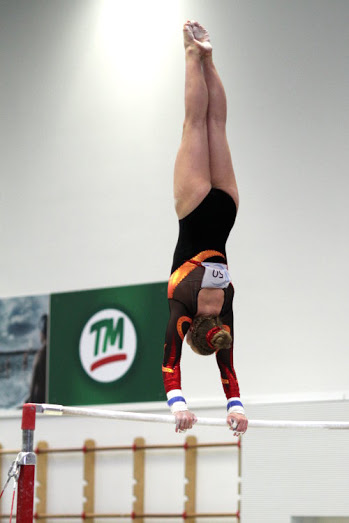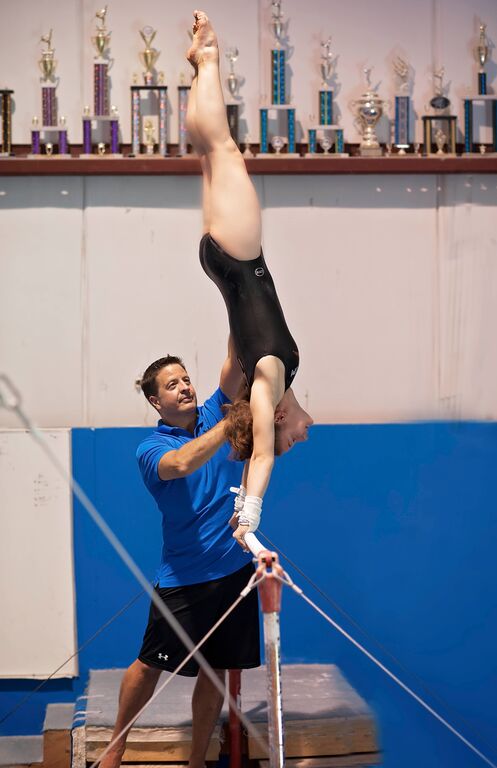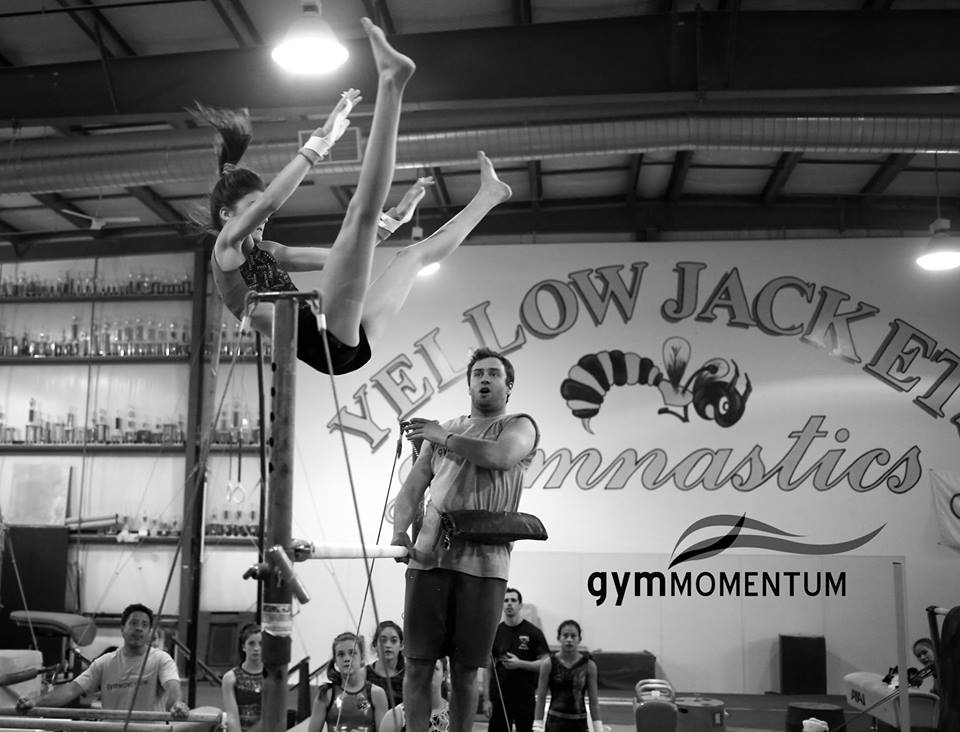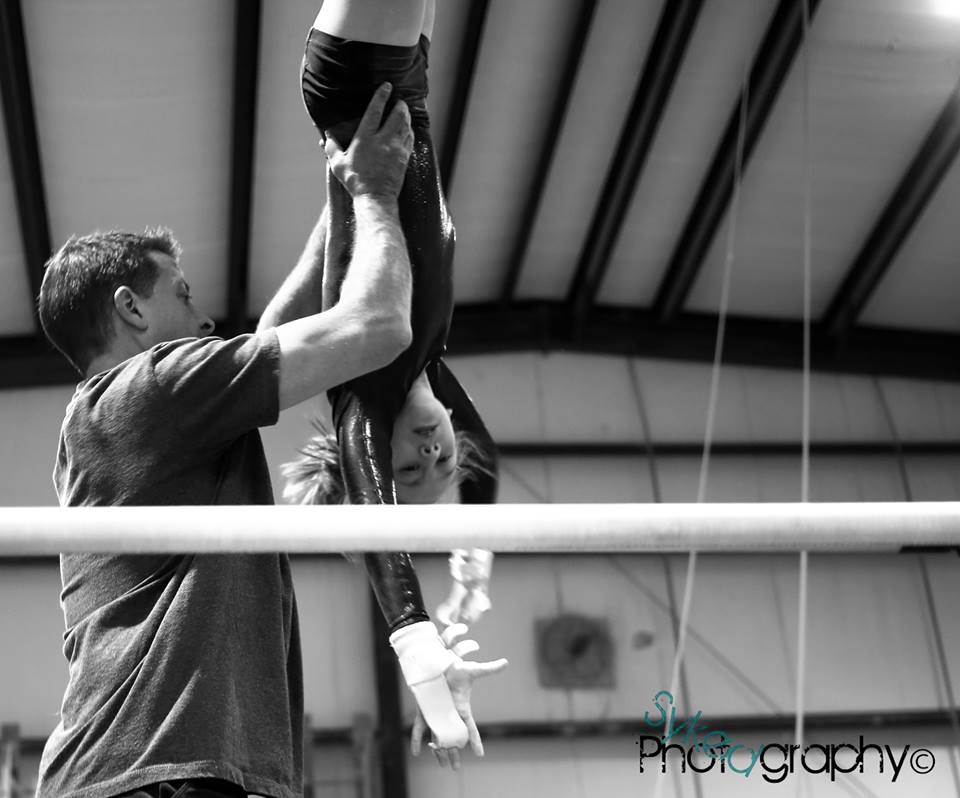This is a LONG way from being a complete list but here are drills I tend to go to every day.
A few of my favorite bar drills
Coaching Bars can be exhausting. You are spotting cast handstands and in bar skills by the millions. You are shaping the gymnasts, trying to get in routines and extra skills. As I have stated previously you need to stay about 18 months AHEAD in order to continue to progress.
Here are some drills for the gymnasts to do alone while you spotting or working on other things.
Cast Handstand Training
In Developing A Plan For Bars I wrote about the importance of having a plan to teach skills in the right order. There are few skills that are more important (or more deducted) than the Cast Handstand.
I had a coach ask me, “is there a way to teach cast handstands WITHOUT spotting?” In short. NO. Or at least not that I have found.
I am not a proponent of mindlessly spotting casts over and over and HOPING that a gymnast can figure it out. Like everything, you need a plan.
Reasons for spotting:
MUSCLE MEMORY through repetition of the correct BODY POSITION
Alleviate Fear. Most have hear of falling over. That is why in the process I teach a 1/2 pirouette. They will know what their body has to do if/when they fall over. I also make sure I spot cast handstands on the high bar as well.
Cast Handstand Progression
Handstand Shape.
- Handstand Hold
- Handstand Walking (lead up to pirouette)
- Handstand Hold on Floor bar (pirouette to come down)
- One Arm Handstand on Floor Bar
- Handstand pirouettes on floor bar
Strength Exercises
- Press Handstands
- Bungee Pulls
- Weight Pulls (Mean 18 – 6 all the way up, 6 1/2 way up, 6 from horizontal to all the way up)
- Planche leans
Spotted Exercises
- Swing on P-bars to get them to lean over
- Swing up to Handstand on P-bars
- Small Casts for Form
- Cast Handstands Pirouette out
- Cast Handstand in Undergrip
- Spotted Casts on High Bar
Here are a few of the drills I use that do not need spot. I do believe you need to monitor everything to ensure correct body positions.
Some Spotted Drills
Straddle Cast Handstand Drills
I am sure I will be adding to this.
Send me YOUR IDEAS!
Developing a Plan for Uneven Bars
Developing a Plan for Uneven Bars
If you are going to be successful at coaching bars, you need a plan. Every gymnast is going to be a little different, every group of gymnasts you have will be different from past groups. Knowing this, when you create your plan keep it general. You will fill in the specifics later based on the needs of individuals. There can be no generic plan. I think the best way to get an idea for YOUR plan is an example of what goes in to mine.
I will be posting a few of my favorite drills for all of these skills in the near future BUT It must start with a plan.
Let me know your thoughts and share your favorite drills
The 18 Month Rule.
Once you get past Level 3, you need to make sure that your gymnasts stay about 18 months ahead with the skills they need for the future. (They should be about twice that on floor!). I have been in gyms where it took nearly the entire bar workout to get the gymnasts through their routines. Dividing my bar workouts into thirds.
- Routine work and specific conditioning.
- Problem Parts and drills
- New skills and combinations
I like to make sure is that the gymnast gets their dismount first. They should have a dismount that they can compete and a dismount that is in their training routine. My reasoning is that if they are comfortable with their dismount, they can focus on the other elements in their routines. As they go into competitions their routine will be newest skills to oldest skill.
Fly Away
I teach fly aways with little kids (level 3) on low bar. Why? Because they are little and light! I do NOT teach tuck flyaways. I go right to layouts. My theory is that a body will follow its feet. If they tuck their feet are CLOSER to the bar. Most kids are afraid of kicking the bar. You might as well teach them to swing up and away in a layout.
- Swing to flyaway
- Cast to flyaway
- Clear hip (or Toe on HS) to Flyaway
- Giant to fly away
A gymnast should be able to do a fly away from all 4. You never know when or how they will need it in the future.
Front Fly away
I teach this and let them do it alone over the pit pretty young. Reality is that when they are learning this they are falling faster than flipping. They are getting comfortable with a front flip. Most gymnasts do not swing hard enough so many will do a pike or ugly tuck. This doesn’t make me happy but I do not worry about it too much.
Cast Handstands
We all agree that cast handstands take a HUGE amount of time. We spot these (or should) everyday. Hundreds if not thousands of repetitions. I like to introduce the cast to handstand as early as level 3. While I am teaching cast handstands I teach a 1/2 pirouette at the same time. Many beginner optional gymnasts have a lot of fear with falling over the bar on cast handstands. So I teach a pirouette at the same time. If they are comfortable with falling (and turning) they will go for it harder. It takes countless repetitions. Be patient.
Inbar skills
The next thing we spend a lot of time coaching and spotting on bars are inbar skills. For most of the gymnasts that is clear hip circles and toe on handstands. I start every gymnast with clear hip circles but move to toe on handstand pretty quick. I feel that I can spend 80 hours working with a group of 10 gymnasts and get 1 really good clear hip circle (but still with some inconsistency) and maybe 2 other with reasonable clear hip circles. 2 more that occasionally make it to handstand and the rest really struggle with form, handstands etc. Spending the same amount of time on Toe on Handstands I have found more success and those gymnasts transition more easily into stalders.
- Clear hip
- Toe on handstand
- Stalder Endo
- Inside stalder Inside Endo
Giants
This skill is often looked at as the make or break skill for many beginner optional gymnasts. You need it to be competitive at Level 7 and it really is a must for all advanced skills that come after that. I have always tried to teach front and back giants at the same time. Many of the drills are the same. It is important with front giants to also teach a “beat tap” as opposed to an uprise tap. With out this tap the gymnast will struggle with Jaegers or double fronts. If a gymnast does not front giant they will never be totally comfortable with pirouettes.
When learning giants I want the gymnasts to be comfortable swinging in all grips (over grip for back giant. Under grip and “L” (eagle) grip for front giants) and facing both directions.
Turning Giants
Once a gymnast can front giant (with spot) I want them to begin to pirouette (blind changes and higgens). This is nearly simultaneous. I want the gymnasts to be relatively free from fear swinging in under grip before they blind change. If they know what is going to happen going over the bar when they pirouette and what their body is going to do under the bar, they will be more comfortable in doing the pirouette. REMEMBER to teach a gymnast how to pirouette OUT of their front giant and how to FAIL. The more comfortable they are, the more aggressive they will be in their tap and the more willing they will be to experiment (play) with new skills.
Release Moves The Big 3. Jaeger, Tkatchev, Gienger.
I start everyone with drills for Jaeger and Tkatchev. Those 2 share a lot of the same drills and the hecht action is necessary for the toe on “hic-cup” to high bar.
The Jaeger is my current preference to push early because I think it may be the most difficult and therefore takes the longest to learn. If a gymnast has a blind change to Jaeger they have at least +.2 in bonus and fulfill 3 special requirements in that they turn, they have a release move, they are in under grip.
The Tkatchev as I stated shares many of the same drills as Jaeger and helps in other skills. This needs to be viewed as a BASE in that there are SO MANY skills that use that action (Hic-cup, Tkatchev, Maloney, Ray, Shaposhnikova, Hindorf, Kim, etc). A Tkatchev also has a fairly large margin of error and still be able to catch.
Gienger- I have been pretty successful teaching kids this skill but I view it more as a skill for the right gymnast. One who has a big “floaty” flyaway.
PAK/ OVERSHOOT
At the JO level I think many gymnasts have an easier time with a Pak because they can set the bars WIDE and have the low bar higher than FIG which helps hide some of the common problems. Although I do NOT think the skill itself is that complicated, keep in mind that most gymnasts are going to need to Kip cast 1/2 pirouette out of it. If you have a gymnast who struggles with pirouettes, you may want to teach an over shoot.
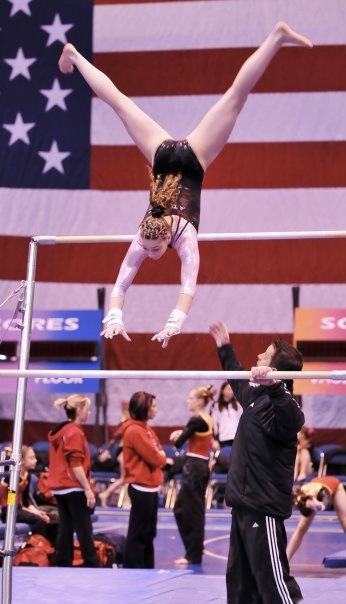
I teach overshoots and Paks at the same time and then see which is best for which gymnasts based on their fear and potential.
This is the first in a series of posts. I will be breaking down and posting drills for each skill.
Presentation
Crash of The Week. Yurchenko Gone WRONG
Crash of the Week. Yurchenko Gone Wrong!
[Read more…]
Vaulting Guide
The video I used for my Vaulting Lecture for Judges at the NAWGJ conference in NJ
and just for fun
Developmental & Competitive Trampoline Program
At Gym Momentum Camp in Boston, Jeremy Mosier, presented a lecture/ demo on Trampoline. How to use it to help your developmental and competitive team. Many coaches asked for the notes- here they are!
PEGASUS GYMNASTICS
DEVELOPMENTAL and COMPETITIVE TRAMPOLINE PROGRAM
Basics:
Straight Jumps-Arms down
Straight Jumps-Arms up
Straight Jumps-Swing arms
Tuck Jumps
Pike Jumps
Straddle Jumps
Jump ¼ turns with arms up and down
Jump ½ turns with arms up, down and circle
Seat Drops
Doggie Drops
Proper Stomach Drops to mat
Proper Back Drops to mat
30 Straight Jumps with proper arms circle
1/1 turns with arms up, arms down, and swinging into it
Flat back drops with arms at ears
Flat Stomach drops with arms at ears
Proper back drops
Proper stomach drops
Spatial Awareness and Tight Body Drills:
Back Handspring to stomach onto mat
Front support bounces
Rear support bounces
Flat back drops ½ turn to flat stomach drop with arms at ears
Flat stomach drop ½ turn to flat back drop with arms at ears
Flat back drop ½ turn to flat stomach drop ½ turn to flat back drop with arms by ears at all time
Flat stomach drop ½ turn to flat back drop ½ turn to flat stomach drop with arms by ears at all time
2x flat back drop ½ turn 2x flat stomach drop ½ turn 2x flat back drop all done with arms by ears at all time
Jump ½ turn to stomach and back drop with arms at ears the whole time
Handstand hops on trampoline as many times as possible
Long front support bounces (hands and then feet, like a rocker)
2/1 turns with arms up, arms down, and swinging into it
Jump ½ turn to handstand arms at ears the whole time
10 back tucks in a row
10 front tucks in a row
Codi and Bailout Drills:
Back drops in a row (needles)
Stomach drops in a row with proper arm push
Back drop to stomach drop with straight body in the air
Stomach drop to back drop with straight body in the air
¾ front layout
¾ back layout
¾ back layout to stomach drop, pull to back drop with straight body into a pull over
¾ front layout to back drop, porpoise
¾ back layout, codi tuck
¾ front layout, ball out tuck
Front and Back Rotations:
Back handsprings
Front handsprings
Back tucks
Front tucks
Back tucks with kick outs
Front tucks with kick outs
Front pikes
Front pikes with kick outs
back pike with kick outs
Back layout
Front layout
Standing back tucks
Standing front tucks
Back tuck with arms up the entire time
Leaps and Jumps:
Split leap both sides
Switch split both sides
Advanced Spatial Awareness and Tight Body Drills:
Jump 1/1 and 3/2 to stomach drop and back drop with arms at ears the entire times
Long front support bounces snap feet under to stand or over rotated
Flat back pullover to handstand
Jump 2/1 and 3/1 turn to stomach drop and back drop with arms at ears the entire time
Back drop to handstand with arms up (forward)
Stomach drop ½ turn to handstand arms up the entire time (forward and backwards)
Long front support bounces, from hands into back layout with arms at ears
Back drop ½ turn to handstand to feet arms up at all times (forward and backwards)
Stomach drop front layout with arms up
Advanced Front and Back Rotations:
Back layout with arms up the entire time
Front layout with a ½ turn
Front layout with arms up the entire time
Back layout ½ with really late twist spotted if necessary
Back layout 1/1 with really late twisted spotted if necessary
front layout 1/1
1 ¼ front to stomach drop
Standing back ½ in puck position
Back layout 1 ½ twist
Front layout 1 ½ twist
Spotted double backs
Double fronts
Back layout 2/1
Double backs
Double back with arms up the entire time
Pak Salto Drills
One of the biggest problems with Pak Salto is controlling the rotation.
TOO MUCH- You skid across the floor on your butt
TOO LITTLE- You eat the bar
Here are drills that I use for control and reach. I try to establish these drills pretty easy because they share some of the same actions with other skills like fly away and over shoot on bars and even the Yurchenko on vault.
I try to make 1 or 2 of these drills an everyday thing.
[Read more…]
Shoposhnikova Drill
The other day I was listening to some coaches brag about the difficulty and intensity of their workouts leading up to a competition. My question is:
“is that intensity and difficulty contributing to the gymnasts success or is it hard just for the sake of being hard?”
Cramming for an exam is a time-honored practice for most students. Gymnastics competitions like tests are stressful, sure, but you can not cram for a competition.
Excellence in gymnastics is rarely determined the week before the competition. It is determined through consistent training in the WEEKS and MONTHS prior to the competition. This is a lesson many gymnasts and coaches forget. There should be some intense and difficult parts of the training cycle but each training sessions should have attainable goals. Whether that is skill acquisition or a set amount of routines.
Coaches need to remember that there are only 2 guarantees for gymnasts.
You are going to get hurt.
You are going to be frustrated.
If a coach has a plan to deal with injuries they will be able to alleviate some of the frustration. Recently I was working with a gymnast who was coming off a lower body injury. Nothing serious but it reduced the amount of time that she could train and the events she could do. Essentially she was only allowed to do bars.
Realistically how much was she going to accomplish at bars? She could not do 4+ hours of bars every day without risking injury.
I needed to come up with a plan to continue the progress on bars with out burning her out.
It is very important to have the gymnast involved with the plan.
What are her goals?
Short and Long Term?
What is the work load she feels she can handle?
With this gymnast she has a very good clear hip and hecht action. The decision was made to work Tkatchev and Shopashnikova. 2 skills with the same action.
These are basic questions every coach should ask on an ongoing basis as a check to make sure training is on target.
What are you doing?
Who are you doing it with?
Is what you are doing appropriate for who you are doing it with?
Why are you doing it? Is it NEED to do or NICE to do?
How are you doing it? Is there a better way or a better mode?
When are you doing it? Is it appropriate for the time of the training years and even the stage of the athlete’s career?
And always use the KISS strategy. Keep It Simple, Stupid.
Clear Hip and Giant Lecture Notes
CLEAR HIP CIRCLES AND GIANTS
TONY RETROSI
tony@gymmomentum.com
5 SKILLS EVERY GYMNAST NEEDS TO BE SUCCESSFUL
THE BIG 5
KIP
CAST HANDSTAND
CLEAR HIP HANDSTAND/ Other in bar skill
GIANT
FLYAWAY
Where it all starts
Straight
Hollow
Tight Arch
Arm extension
THE HANDSTAND
Clear Hip Circle
Body Shape Rules
Strong CORE Strength. (What is your Core?)
Ability to Hold Static Shape BEFORE you try to move through it
Work parts independently as well as together
Body weight, the light resistance, increase resistance with out losing shape.
Important Shapes
STRAIGHT
HOLLOW
ARCH
Clear hip/ Toe Hand/ Stalder Drills
Back Hip Circles in a row. Straight Body
Baby clear hip circles in a row. Getting bigger. Maintain Shape
Quick turns on strap bar (too much time bad for wrists)
LOTS and LOTS of Back Extension Rolls
Press Shaping
for Toe Handstand and Stalder
Jump Clearhip/ Toe on
Drills
Jump to toe circle
Double leg jam
seat circles
Basket swings
Down Swing
Clear Hips in a row
Wyler
GIANTS
The “up swing”
Many of the same drills as CLEAR HIPS
REVIEW
Maintain body shape
Opening of Arms
Toes lead the way
Neutral Head Position
DOWN SWING
